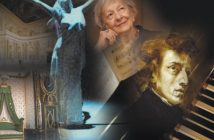克拉科夫的国王大道是最著名的旅游线路,沿着这一线路聚集了数量众多的古迹 – 不仅有最高级别(0级)的古建筑,也有大量的旧住宅楼,生机勃勃的小街道,漂亮别致的建筑造型。
国王大道起始于弗洛里安大门。这里也是克拉科夫最漂亮的街道 – 弗洛里安斯卡大街的起点,它一直通往中心广场,然后经格罗兹卡和卡诺里查街一直到瓦维尔高地。在那庄严的城堡中居住过波兰的国王们。那里还有大主教座堂, 其中举行过国王加冕典礼,也是国王死后的安葬地。那里还有全波兰最著名的齐格蒙特大钟。
* 弗洛里安大门 – 建于十四世纪初。 – 它是城市的主大门 — 八个进出克拉科夫的城门之一。它曾与巴尔巴坎门联成一体。在城门上可看到按照波兰最著名画家马泰伊柯的设计方案制成的皮雅街可夫斯基雄鹰图案。靠市区一侧是它的守护神 — 弗洛里安。
城墙及塔楼 – 城市城墙绵延约达4公里,沿着城墙建有47座塔楼。被修复的只有几座。从市内一侧看弗洛里安大门左边是细木工塔楼(十五世纪)和木匠塔楼(十四世纪)。这两座塔楼之间是军火库。大门右侧是杂货商塔楼(十五世纪)。
弗洛里安斯卡大街 – 第45号楼房,其中有著名的咖啡屋“雅玛 米哈里卡”。第41号是扬.马泰伊柯博物馆。第14号是克拉科夫最古来的玫瑰旅馆,它有十六世纪文艺复兴时期的漂亮大门。
玛利亚广场 – 十四世纪时,这里建成了圣女玛利亚教堂,也就是玛利亚教堂。从教堂高塔中每隔一小时都有号角吹响。教堂中有著名的介绍耶稣和玛利亚生活情景的神坛(十五世纪)。
中心广场 – 城市中心 – 它是中世纪最大的城市广场,占地约4公顷。可能与普郎特地区的城市系统一样,是1257年在确定克拉科夫城时标定的。
布商市场- 这个以前进行裙装贸易的中心原为哥德式建筑,十五世纪时改建为文艺复兴时期建筑。在其中的第二层是波兰绘画精品。广场角落的圣.沃伊泰克小教堂为罗马式建筑(十一、十二世纪)。广场上值得一看的还有带钟楼的市政厅塔楼和守护其入口的狮子雕像以及波兰诗人亚当.密茨凯维奇的纪念碑。围绕纪念碑摆放的座椅既是供克拉科夫人休息的,也是供游人休息的。
格罗兹罗卡街 – 沿着从前的市前商业街向瓦维尔宫前行时,请注意街左边显著位置被修复的漂亮的多米卡努夫教堂。在街道右边稍远处屹立着维罗波内尔斯卡宫,克拉科夫市政府就设在其中。在十三世纪建成的弗郎奇什努夫教堂旁边,请注意十字路后边带各种标记的旧住宅楼。第32号楼被称为狮子旁边的屋 — 其标记为狮子(十四世纪),第38号为Elefanty(十七世纪的标记),第53号为 Collegium Iuridicum(十四世纪)。
圣.彼德和保罗教堂 – 这是克拉科夫最古老的巴罗克建筑,是十七世纪初为耶稣传教团建造的。
圣.安德烈教堂 – 是十一世纪建造的罗马式建筑。
在卡罗里卡街上 – 穿过圣玛利亚.玛格达内娜广场,可看到许多十五、十六世纪的住宅楼。这里有大主教区博物馆,收藏有大量的波兰教皇约翰.保罗二世去世后的纪念品。
瓦维尔宫 -位于卡尔里卡街的前端,从这一方向可以看到的宫殿北翼及1921年建成的从赫尔波瓦大门进出的主教座堂。在弗瓦迪斯瓦夫四世国王棱堡上树有1794年起义领袖 — 塔德乌什.科西秋斯柯的纪念碑。从路南的贝尔纳尔丁斯卡街可看到贝尔纳尔丁教堂。

The Royal Way
It starts at the Floriańska Gate, from where one of the city’s most attractive streets, ulica Floriańska, starts and leads up to the Main Market Square. Across the square, ulica Grodzka and then ulica Kanonicza lead up Wawel Hill to the castle, the imposing residence of Polish kings. The cathedral, once used for coronations and where many kings lie buried, stands at the top of the hill. The best-known church bell in Poland, the Sigismund Bell, hangs in the cathedral tower.
Floriańska Gate – Built at the beginning of the 14th century, it used to be the city’s main entrance gate, one of eight city gates, and was once connected with the barbican. The Piast Eagle which was placed above the gate proper was made according to a design by famous Polish painter Jan Matejko. There is a relief depicting St Florian, the patron of the gate, on the side of the old town.
Walls and Keeps – The city walls were about 4 km long and once included 47 keeps, of which only several have survived. Looking up to the Floriańska Gate, the Stolarska Keep (15th c.) and the Ciesielska Keep (14th c.), with the old city arsenal in between them, can be seen to the left. The Pasmoników Keep (15th c.) can be seen to the right of the gate.
Ulica Floriańska – There are many emblems on the front walls of the houses along the street. No. 45 deserves special attention as it houses the famous Jama Michalika cafe. At no. 41, in the house where the artist Jan Matejko once lived and worked, there is a museum. The Pod Różą Hotel, Cracow’s oldest, with a beautiful Renaissance portal dating back to the 16th century, is at no. 14.
The Church of St Mary – Built in the 14th century. Every hour a bugle call is played from the taller of the church’s two towers. Inside the church is the famous 15th-century altar carved by Veit Stoss, depicting scenes from the lives of Jesus and Mary.
Main Market Square – The centre of the city, and Europe’s largest medieval city square, covering an area of about 4 ha. It dates back to 1257.
Sukiennice (The Cloth Hall) – This building was a centre of cloth trade centuries ago. Originally built Gothic in style, it was rebuilt in the Renaissance style in the 15th century. The first floor houses the Gallery of Polish Paintings.
The small St Adalbert’s Church at the corner of the Square was erected in the Romanesque style (11th/12th c.).
Town Hall Tower – The only remains of a 16th-century town hall. There are big clocks on it, and two stone lions guard the entrance.
Statue of Adam Mickiewicz – A monument to the Polish national bard Adam Mickiewicz. The benches around the statue are a very popular meeting place for Cracovians and tourists.
Ulica Grodzka – Runs along an old trade route used before the founding of the town. Walking towards Wawel, you cannot miss the beautifully restored Dominican Church on the left. On the right in the background is the Wielkopolski Palace, which houses the offices of the municipal authorities, and next to it stands the Franciscan Church (13th century). Further along ul. Grodzka there are buildings with interesting coats-of-arms on their fronts. At no. 32 stands the 14th-century Podelwie House. Its emblem is a Gothic lion. The emblem of the house at no. 38 comes from the 17th century. The house at no. 53 is the Collegium Iuridicum, which dates back to the early 15th century.
The Church of St Peter and St Paul – The oldest baroque structure in Cracow, built at the beginning of the 17th century for the Jesuit Order.
The Church of St Andrew – Romanesque church from the 11th century.
Walking across St Mary Magdalene Square leads to ulica Kanonicza, in which there are many buildings dating from to the 15th and 16th centuries, and the Archdiocesan Musem, in which memorabilia of the late Pope John Paul II are exhibited.
Wawel can be reached from two sides. From the north, where the cathedral and the northern wing of the royal castle can be seen. The Coat of Arms Gate at the top of the route was built in 1921. A monument to Tadeusz Kościuszko, the glorious leader of the Insurrection in 1794, was put on the bastion of King Władysław IV. The southern road leads from ulica Bernardyńska and the Bernardine Church










